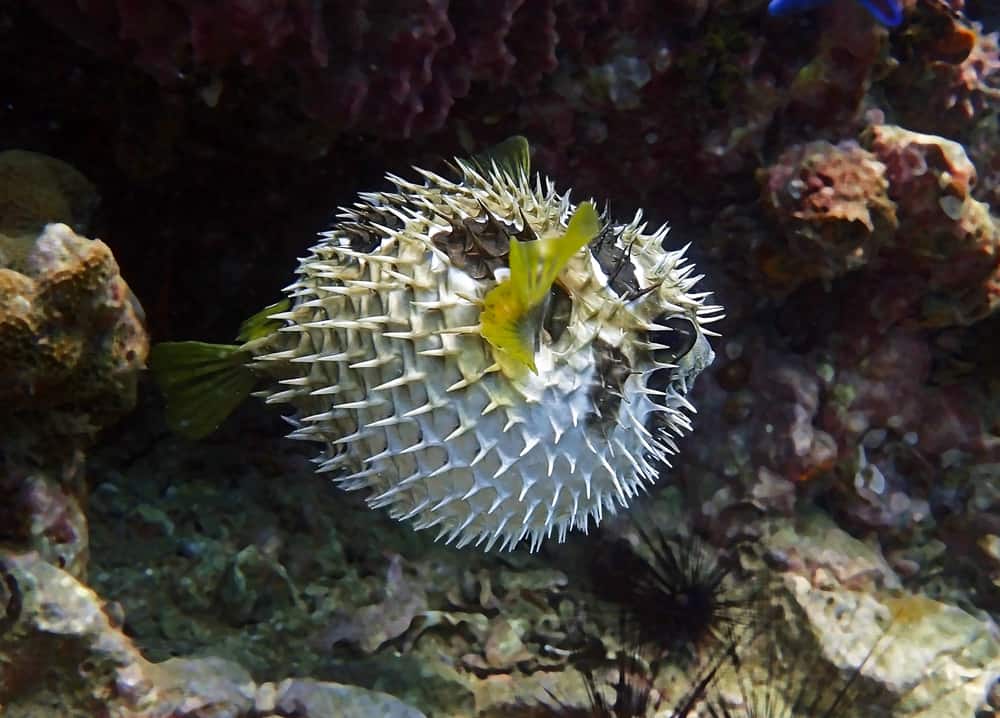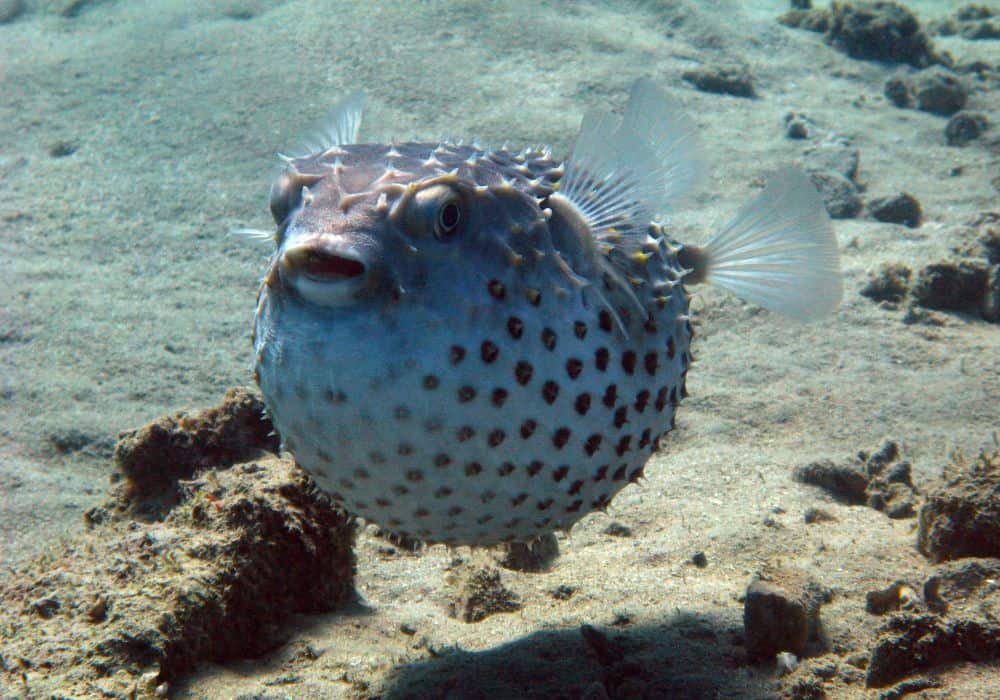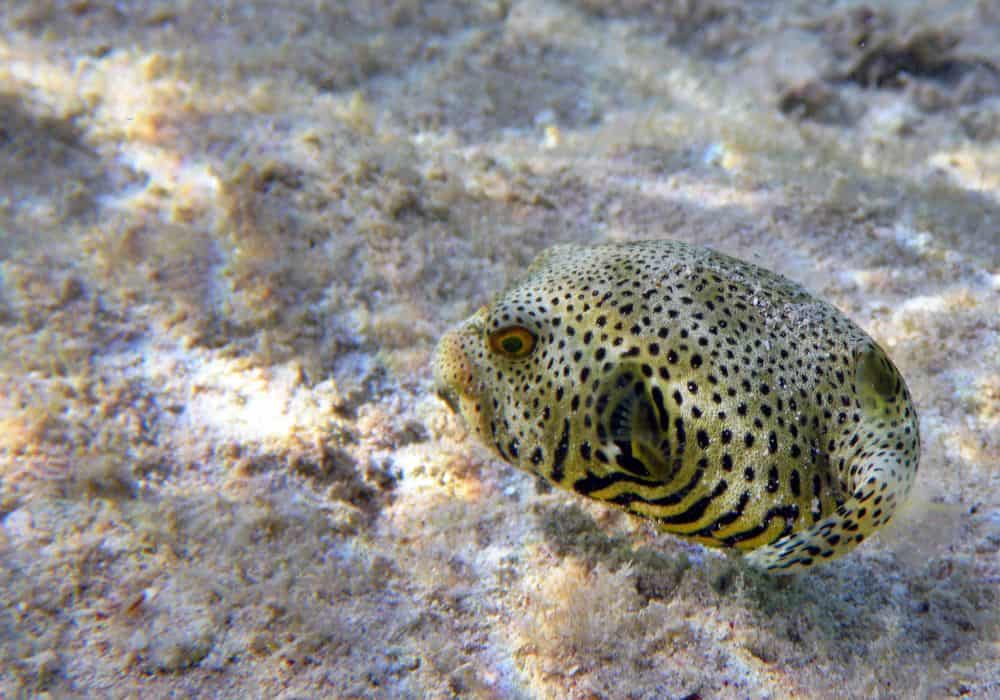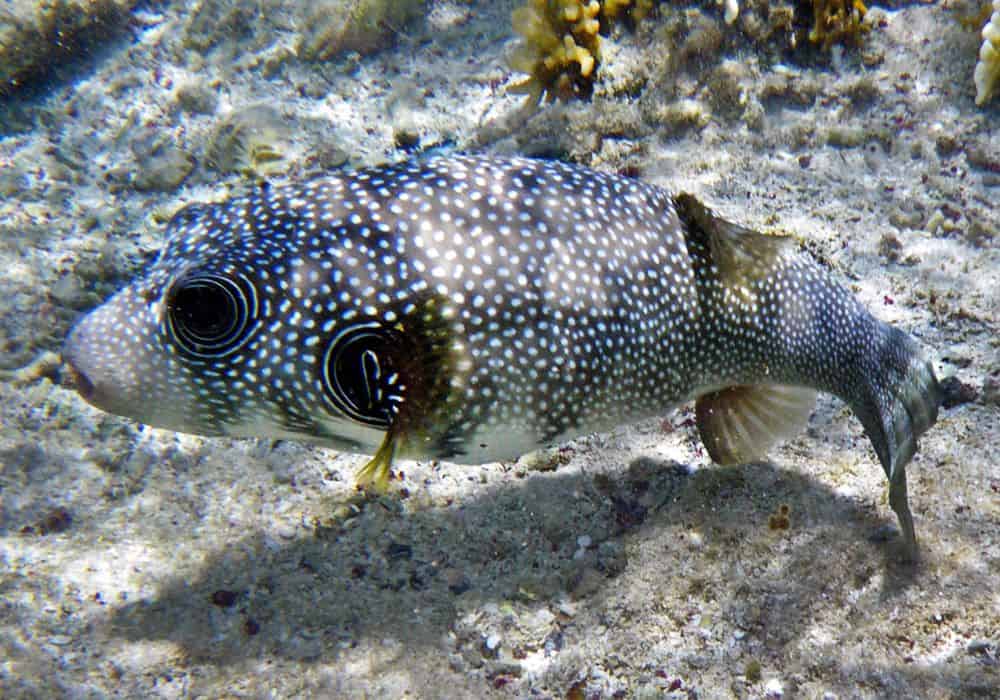Have you been considering getting a pufferfish? Or have you recently added one to your aquarium? It is important to do your research before getting one or just after adding one to your aquatic menagerie, so you have come to the right place.
Pufferfish are a popular addition to aquariums thanks to their unique shape and abilities. They have a diverse diet that may be unexpected, and pufferfish owners may not know what is best to feed their fish to keep them healthy and happy.
We will look in depth at the types of foods pufferfish most enjoy, what wild pufferfish eat when in their natural habitat, and provide you with helpful tips for looking after your pet pufferfish.
What Are Pufferfish?
Pufferfish are a species of scaleless fish that can be found in both freshwater and saltwater. Some species of pufferfish (around 40) regularly move between both habitats yet still thrive. They have the unique ability to puff up their bodies by filling their stomachs with water.
They often ambush their own predators and release a toxin when they sense one is nearby. This is a deadly toxin that is poisonous and can often be fatal to animals that come into contact with it. Because of this, you should try to get a non-toxic species for your aquarium.
When they aren’t inflated with water, pufferfish are small and usually have black spots that cover their body. Freshwater pufferfishes are the best kind to add to an aquarium as they require less water maintenance than saltwater species but are still high-maintenance fish.
They are slow swimmers despite having multiple fins, including a rudder fin that guides them in the direction they want to go. Some people consider the pufferfish to be a dietary delicacy. In Japan, there is a dish called Fugu, or pufferfish fillets.
What Do Pet Pufferfish Eat?
Pufferfish are omnivores, meaning they eat both meat and plants. However, pufferfish have another unique feature that most fishes don’t – they have teeth that are fused together to form hard beaks.
These teeth never stop growing so require some form of maintenance. They enable pufferfish to eat creatures that would be unsuitable for other fish, such as clams, shrimps, and aquatic snails.
This hard-shelled diet helps take care of their teeth even when living in an aquarium as they wear them down naturally to stop them from overgrowing. If they don’t get this, then they may need to have some form of veterinary procedure to file their teeth down.
Below is a list of foods suitable for pet pufferfish, as per A-Z Animals and Fantasea Aquariums:
Frozen Foods
Frozen foods that can be given to pufferfish in captivity include:
- Whitebait
- Mussels
- Shrimp
- Squid
- Clam
- Bloodworms
Be sure to defrost any frozen foods in a container of water that has been taken from the aquarium before giving it to the pufferfish.
Fresh Foods
Pufferfish prefer fresh foods over frozen and can eat the following:
- Clams
- Mussels
- Oysters
- Whitebait fish
- Squid
- Aquatic snails
- Algae wafers
- Unpeeled shrimp
- Bloodworms
- Coral
- Krill
- Cockles
- Crabs
- Other crustaceans
Remember to keep all the shells on the shellfish before feeding it to the puffer fish. A mixture of plants and meat is best, but you should try to give them more meat products than plant products.
Clams and oysters should only be fed to fully grown adult pufferfish, as younger pufferfish don’t have strong enough teeth to be able to crack open their shells successfully.
Live Foods
Sometimes, you can get a couple of live creatures to feed your pufferfish if you have access to a trustworthy supply and if you are comfortable with doing so. It isn’t necessary to give them live food, but if you can, the following are suitable:
- Crayfish
- Shrimp
- Crabs
The risk with live food is that they can contain parasites or harmful bacteria that, if consumed, can make your pufferfish very ill and may even cause an outbreak of disease through the entire aquarium.
It is very important to make sure the creatures have come from a reputable source and are completely free of disease and parasites before they are given to your pufferfish. Also, a pufferfish’s toxin (called tetrodotoxin) comes from the foods they eat, so be wary.
Are Pufferfish Dangerous to Humans?
Pufferfish can be dangerous to humans if ingested or if they are exposed to their toxin in other ways. Almost all species of pufferfish contain tetrodotoxin, which is said to be 1200 times more deadly than cyanide, another poisonous substance.
Despite this, many people eat pufferfish, or Fugu, in Japan and only highly trained chefs are permitted to cook with the meat harvested from the fish. One badly cut fillet can mean almost certain death for the unlucky diner.
Unfortunately, though it is uncommon, there have been instances where this has been the case. Around five deaths per year are recorded as having tetrodotoxin poisoning after consuming pufferfish as the cause.
A single pufferfish reportedly has enough toxin to kill 30 people within them, and as of July 2022, there is no antidote for tetrodotoxin poisoning. They produce the toxin through the food they eat, as it tastes good to a pufferfish but has awful effects on humans.
Tetrodotoxin poisoning paralyses the body by stopping the production of sodium, and eventually causes death by asphyxiation. It is far more likely that you will have a pufferfish that is poisonous than one that is not, so be very careful.
However, it is unlikely that you will have any adverse effects from having freshwater puffers as pets so long as you don’t eat or touch them. Avoid touching the spikes as they have the toxin in them, and make sure that there are no other living creatures in the tank with them.
Tips For Taking Care of Pet Pufferfish
So, now you know what you should feed your pufferfish and how to avoid their toxin, you may now be wondering how to best care for your new pet.
Disclaimer: Pufferfish are not for beginner fish owners. Only buy a pufferfish for an aquarium if you have owned fish before and are fully informed about the risks and requirements of looking after them.
Below are a couple of helpful tips to aid you on your journey as a pufferfish owner:
- Don’t put pufferfish in a tank with any other fish. They are predators and will attack or eat anything outside of their species. They are happiest living alone.
- They require a lot of space, so ensure you have bought a big enough tank for them to thrive and be happy.
- Carry out regular water checks to make sure the water quality is at the optimal level. You should measure the ammonia, nitrite, and nitrate levels, and if you don’t know how, then many pet stores offer a service that checks it for you.
- If the ammonia, nitrite, and/or nitrate levels are too high or low, it indicates that the water quality is bad; it’s dirty and needs to be changed. If it isn’t dealt with quickly, your pufferfish will become ill and eventually die.
- Pufferfish aren’t cheap to buy and are a high maintenance pet. To cut down on food costs, try getting reduced fresh fish at the end of a day so long as it is still fine to eat, and freeze different foods to make them last longer.
- They have a life expectancy of up to 10 years, so it is not a short-term investment and should not be entered into lightly.
- Remember not to feed them any commercial fish foods like pellets.
Conclusion
To conclude, to adequately feed a pet pufferfish you should give them a varied diet that includes the following:
- Whitebait (any sort) fish chunks
- Shellfish:
- Clams
- Mussels
- Crab legs
- Oysters
- Crayfish
- Aquatic snails
- Shrimp
- Algae
- Squid
- Bloodworms
- Coral
- Cockles
If you have any comments or queries about anything you have read, please leave them in the box below and we will get back to you as soon as possible.
FAQs
Can Pufferfishes Eat Ordinary Fish Food?
The short answer is yes, but it isn’t the most ideal diet for a pufferfish and has to be combined with other foods on the above list.
They can adapt to a high-protein diet of flakes, pellets, and various worms such as mealworms and bloodworms, but they need the shellfish as well to maintain their dental health.
What Do Pufferfish Eat in the Sea?
Wild pufferfish eat a variety of foods. These include:
- Small invertebrates
- Algae
- Clams
- Mussels
- Shellfish
These foods are very similar to those given to captive pufferfish. They provide the necessary vitamins and nutrients necessary for survival whilst maintaining their teeth. There is a ready supply of these foods in the sea, so wild pufferfish rarely have to go without food.




Got a puffer with ick nurseing back to health. Feeding puffer baby daily with frozen shrimp and Ipswich clams fresh. She ate well the first day but not too excited the second day. Do they eat daily or every other day? Please advise.